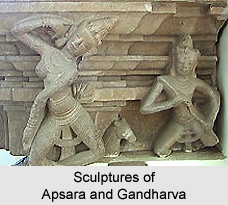 Incantations against demons are quite numerous in the Atharva Veda. Demons are looked upon as the originators of diseases, and consequently a number of incantations are directed against pisachas (goblins) and rakshasas (devils). The object of these spells is the scattering or exorcising of these demoniacal beings. Along with this belief in devilish beings which bring diseases upon mankind, there is also seen the belief in male and female demons, a belief that is shared by the rest of the world. They are said to visit mortal men and women every night. These are the Apsaras and Gandharvas of the ancient Indian popular belief, which correspond in every respect and in an amazing manner with the sprites and elves and fairies of the German popular belief. They are originally the spirits of nature, river and forest-deities. Rivers and trees are their dwelling places, which they leave only to entice mortals and to injure them unnatural co-habitation. In order to drive away these spirits, the ancient Indian magicians made use of a pleasant-smelling plant called Ajasnigi (Odina pinnata).
Incantations against demons are quite numerous in the Atharva Veda. Demons are looked upon as the originators of diseases, and consequently a number of incantations are directed against pisachas (goblins) and rakshasas (devils). The object of these spells is the scattering or exorcising of these demoniacal beings. Along with this belief in devilish beings which bring diseases upon mankind, there is also seen the belief in male and female demons, a belief that is shared by the rest of the world. They are said to visit mortal men and women every night. These are the Apsaras and Gandharvas of the ancient Indian popular belief, which correspond in every respect and in an amazing manner with the sprites and elves and fairies of the German popular belief. They are originally the spirits of nature, river and forest-deities. Rivers and trees are their dwelling places, which they leave only to entice mortals and to injure them unnatural co-habitation. In order to drive away these spirits, the ancient Indian magicians made use of a pleasant-smelling plant called Ajasnigi (Odina pinnata).
The similarity of these incantations and belief in the magical creatures is quite similar to certain foreign beliefs. Just as in the case of the Atharva Veda, the elf in the Sennan incantations is exhorted to leave the houses of Mortab, and to depart to the rivers and trees. Just like the Apsaras and the Gandharvas, too, the Germanic water-fan - elves love music and dancing, with which they lure mortal men and women. Just as in the ancient Indian magic, the Gandharva appears now as a dog, now as an ape, as a youth with beautiful curls, the elf of the German legends makes his appearance in all kinds of transformations. Moreover, just as the Apsaras of the Vedas have their swings in the branches of the banana and fig trees, similarly the water-frames of German popular belief swing in the branches of the banana tree and fig trees.
The point of mentioning all these similarities is that these points of agreement can scarcely be mere coincidences. We may therefore agree with Professor Adalbert Kuhn, who compared Indian and German incantations as long as sixty years ago. He made the deduction that certain phenomena of magic lore and definitely developed forms of magic songs and magic formulas may be traced back to the Indo-European period, and that the German and Indian magic songs thus give a clue to a kind of pre-historic poetry of the Indo-Europeans.



















